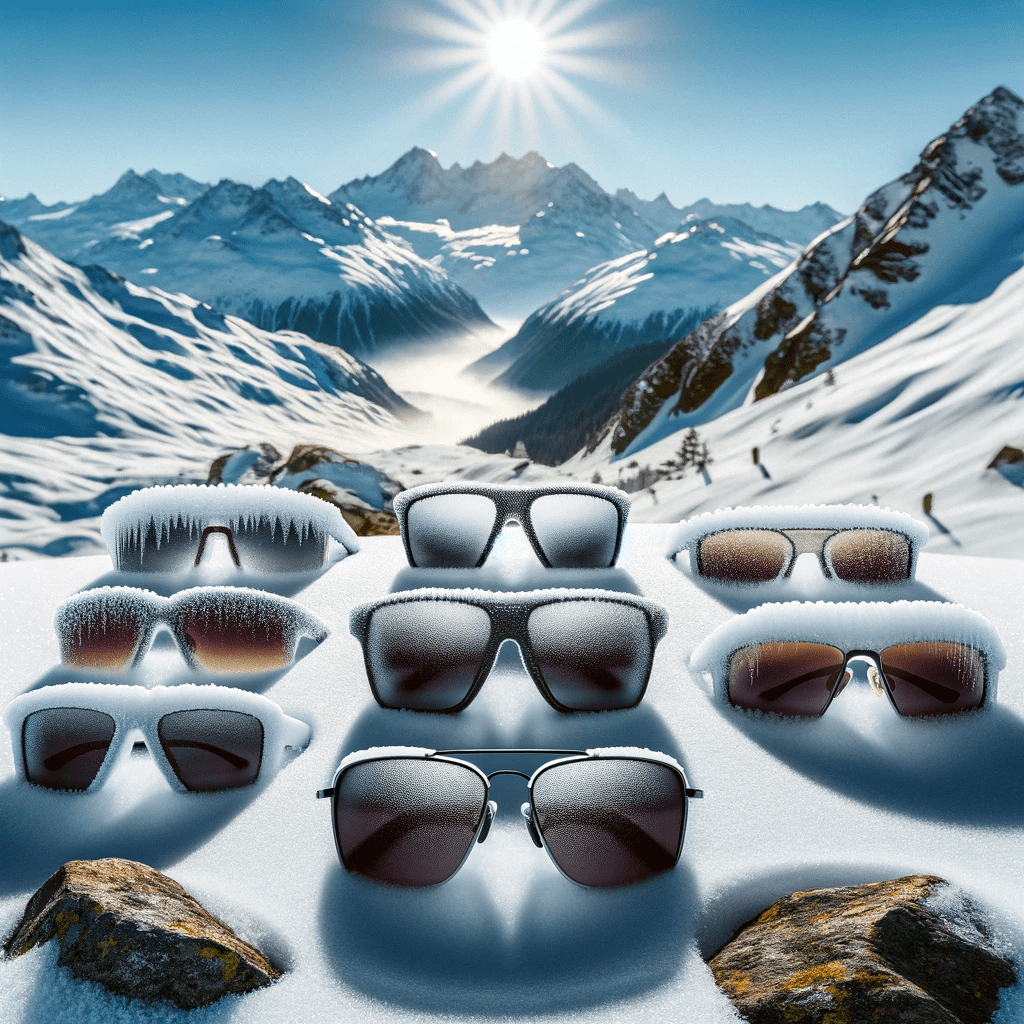6 Tips for Anti-Fog Winter Hiking Sunglasses
6 Tips for Anti-Fog Winter Hiking Sunglasses: Nearly 70% of hikers experience visual impairment due to lens fogging, which can undermine the control and confidence essential to conquering winter trails. I’ve mastered the art of keeping my vision clear in frosty conditions.
It’s not just about having the right gear; it’s about wielding the power to see the path ahead, unfettered by the elements. Let me share my expertise with you through six decisive tips for anti-fog winter hiking sunglasses.
- Choose the right frames
- Apply effective coatings
- Ensure ventilation
- Utilize specialized wipes
- Harness dual-lens technology
- Maintain cleanliness
By following these tips, you’ll retain the upper hand against the fog. Clear sight lines equate to clear paths to victory.
Stay sharp out there.
Key Takeaways
- Choose sunglasses with breathable frames and subtle vents for optimal air circulation.
- Select frames that offer protection from wind and debris.
- Experiment with different anti-fog coatings to find the best formula.
- Consider sunglasses with dual-lens technology for enhanced fog-fighting capabilities.
Select Breathable Frames

I’ve found that choosing sunglasses with breathable frames is key to preventing lens fog on chilly hikes. When the temperature drops, and you’re powering through rugged trails, the last thing you want is impaired vision due to fogged lenses. Breathable frames designed with subtle vents allow air to flow behind the lenses, ensuring that your vision remains clear as you conquer the elements. These frames stand slightly off your face, creating an optimal gap for air circulation without compromising protection from the wind and debris.
Selecting the right pair of sunglasses with such features empowers you to maintain your pace and focus. The sense of control over your environment is paramount, and breathable frames offer just that by managing air circulation effectively. They minimize moisture buildup, ensuring that each step you take is guided by unobstructed sight.
Remember, the objective is to harness the power of innovation to enhance your outdoor experiences. As you consider the various options, look for frames that not only allow air circulation but also align with the intensity of your pursuits.
Transitioning smoothly into the next layer of defense, let’s explore how applying an anti-fog coating can further secure your vision against the trials of winter hiking.
Apply Anti-Fog Coating

After selecting frames that promote airflow, I’ll apply a reliable anti-fog coating to my lenses to ensure they remain clear during my winter hikes. Experience has taught me that a good anti-fog solution can make all the difference in maintaining vision clarity when the temperature drops. Here’s how I make sure I’m in control of my visual field, no matter how frosty it gets:
- Choose the Right Anti-Fog Coating
- Cat Crap is among the top contenders; it’s easy to apply and long-lasting.
- Experiment with different brands to find which formula works best for your adventures.
- Applying the Coating Effectively
- Clean the lenses thoroughly before application to remove any residue.
- Apply a small amount of the anti-fog coating, using a circular motion to cover the entire lens.
- Allow it to dry, then buff it out with a microfiber cloth for a clear finish.
I’m always on the lookout for ways to enhance my gear, and a powerful anti-fog coating is essential. It’s not just about keeping my view unobstructed; it’s about taking command of the elements. With the right anti-fog treatment, I’m unstoppable, even when the winter tries to throw a misty curveball my way.
Ensure Proper Ventilation

In addition to using anti-fog coatings, I ensure my sunglasses have proper ventilation by adjusting them away from my face, allowing for better air circulation. I’ve learned that by creating a small gap between my sunglasses and my face, I help to facilitate the flow of air, which is essential to keep them from fogging up. This isn’t just about comfort; it’s about maintaining a clear line of sight, which is crucial for safety and performance on the trail.
To highlight the importance of ventilation in winter hiking sunglasses, consider this:
| Feature | Benefit | Importance |
|---|---|---|
| Built-in Vents | Directs airflow | Reduces moisture buildup |
| Adjustable Fit | Allows customization for air gap | Enhances airflow |
| Design Efficiency | Promotes continuous air flow | Prevents fogging |
Use Anti-Fog Wipes

I’ve found that using anti-fog wipes is a game-changer when it comes to keeping my sunglasses clear on winter hikes.
It’s not just about wiping them down; there’s a technique to it that maximizes the longevity of their effectiveness.
I’ll share my go-to brands and how to apply them properly, ensuring your vision remains unobstructed on the trail.
Wipe Application Technique
Before setting out on my winter hike, I always make sure to swipe my sunglasses with a specialized anti-fog wipe to prevent any vision-obscuring mist. It’s an essential part of my wipe application technique to keep my sunglasses from fogging. Here’s how I do it:
- Apply the anti-fog wipe evenly:
- Gently rub the wipe in a circular motion on both sides of the lenses.
- Ensure coverage over the entire surface for maximum effectiveness.
This method sets a clear, fog-resistant barrier that empowers me to navigate through the chill without interruption.
Longevity of Effectiveness
To maintain my sunglass lenses’ clarity throughout the hike, I regularly reapply anti-fog wipes to extend their fog-resistant effectiveness.
These wipes, designed for precision instruments like Nikon camera lenses, offer a robust solution for sports sunglasses. I’ve experimented with Smith No-Fog Cloth and Cat Crap, but consistently return to these wipes for their enduring anti-fog properties.
It’s crucial to keep the lenses clean and dry; any negligence here can diminish the anti-fog efficacy.
Understanding the science of fogging, particularly in the cold, aids in preempting obscured vision.
When the situation demands, I turn to specialized anti-fog sprays for an additional layer of defense, ensuring my vision remains unimpaired, commanding the trail with unbroken focus and power.
Suitable Wipe Brands
Among the variety of brands I’ve tried, Nikon’s precision wipes stand out as an effective anti-fog solution for my winter hikes. Here’s why they’re a cut above:
- Nikon Precision Wipes
- Camera Lens Expertise: Leveraged for sunglass lenses.
- Long-Lasting Clarity: Keeps my vision clear throughout the trek.
But let’s not stop there. You want to dominate the elements, so consider these options as well:
- Other Notable Brands
- Smith No-Fog Cloth: Trusted by winter sports aficionados.
- Cat Crap: Odd name, serious performance on a pair of goggles.
Harness the power of these elite tools to maintain an unobstructed view. As you prepare to conquer the trails, consider how you could opt for dual-lens technology for even greater fog-fighting prowess.
Opt for Dual-Lens Technology

I’ve found that opting for dual-lens technology in winter hiking sunglasses significantly enhances visual clarity.
This tech not only reduces the risk of condensation but also serves as an effective thermal barrier, keeping the lenses clear in cold conditions.
It’s a practical choice for any winter adventurer looking to maintain optimal sight throughout their hike.
Enhanced Visual Clarity
I recommend choosing dual-lens technology in your sunglasses to ensure enhanced visual clarity during winter hikes. This superior tech not only battles fog but also sharpens your view, crucial when trekking through low light and complex terrains.
- Why Dual-Lens?
- Thermal Barrier: Creates insulation that minimizes fog-up.
- Air Circulation: Enhances defogging, keeping your view crystal clear.
- Benefits for Hikers:
- Maintained Visibility: In low light, every detail counts.
- Improved Peripheral Vision: Spot potential hazards quickly.
With dual-lens sunglasses, you’re not just preparing for fog; you’re equipping yourself with a tool that ensures command over your environment. You’ll navigate with precision, ready to conquer whatever the winter trail throws at you.
Reduced Condensation Risk
To further mitigate the risk of condensation and maintain a clear line of sight on your winter hikes, I’ll delve into why choosing sunglasses with dual-lens technology is a game-changer.
When I wear sunglasses with this innovative design, I’m arming myself with full coverage against the disruptive fogging caused by temperature differentials. This tech cleverly creates a thermal barrier, which significantly lowers the chance of moisture buildup.
It’s not simply about avoiding the annoyance of fog; it’s about maintaining an unobstructed vision that can mean the difference between a powerful trek and a precarious situation.
The dual lenses promote superior ventilation, ensuring that the warm air generated by my body doesn’t cloud my view. It’s a strategic move for any serious winter hiker.
Thermal Barrier Performance
As a winter hiker, I’ve found that the thermal barrier performance of dual-lens technology in sunglasses is essential for preventing the fogging that can impair my vision on the trails. When the bright sun beams down on snow-covered landscapes, much light is reflected, and the right eyewear is crucial. Here’s why dual-lens tech is a powerhouse against fog:
- Insulation Efficiency
- Minimizes heat transfer
- Maintains consistent temperature between lenses
- Optimal Airflow
- Reduces moisture buildup
- Enhances clarity of vision
This technology delivers uncompromised sight when I conquer the cold, ensuring that my focus stays sharp and unobstructed. With these sunglasses, I’m equipped to dominate the elements.
Now, let’s pivot to the importance of maintaining regular cleaning to sustain the anti-fog capabilities.
Maintain Regular Cleaning

Maintaining the cleanliness of my sports sunglasses is crucial to prevent fogging during winter hikes. I’ve learned that a disciplined approach to regular cleaning not only enhances visibility but also asserts my commitment to a clear vision in every endeavor. This isn’t just about wiping off dirt; it’s about ensuring my sunglasses are in peak condition to face the rigors of the outdoors.
I start by applying a few drops of dishwashing soap to the lenses, gently massaging them to break down any grime. This simple yet effective method avoids the risk of moisture buildup which can lead to fogging. Then, I thoroughly rinse them under lukewarm water.
Next, I use a lens cleaner spray for an added layer of cleanliness. It’s a power move that eradicates any residual particles, leaving a pristine surface. The microfiber cloth is my tool of choice here, its fine fibers caressing the lenses without the threat of scratches.
6 Tips for Anti-Fog Winter Hiking Sunglasses Frequently Asked Questions
How Do I Keep My Glasses From Fogging up in the Winter?
Like a captain steering through mist, I prevent my glasses from fogging by using anti-fog sprays and ensuring proper airflow, akin to setting sails for a clear voyage through winter landscapes.
How Do You Make Sunglasses Fog Proof?
I make my sunglasses fog-proof by applying anti-fog treatments and ensuring they have proper ventilation. It’s about control—I choose gear that won’t undermine my vision when I’m out conquering the cold.
How Do I Keep My Polarized Sunglasses From Fogging Up?
I envision a clear, unobstructed view on my hikes; thus, I apply anti-fog products to my polarized sunglasses and ensure they sit just right for optimal airflow, banishing any trace of fog.
How Do You Get Rid of Fog on Sunglasses?
I eliminate fog on my sunglasses by applying anti-fog sprays and ensuring they fit properly to maximize airflow, which prevents condensation from obstructing my vision during critical moments of decision-making.

